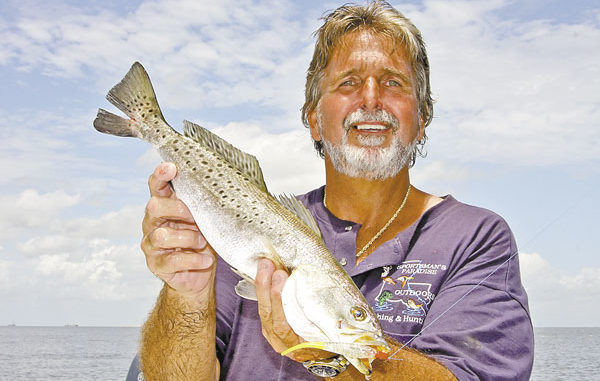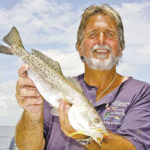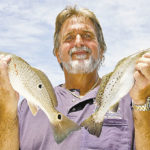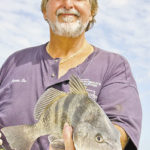
In September, speckled trout transition across this popular and productive lake.
September can sometimes be a difficult month to catch speckled trout. As they make their way in from the exterior lakes and bays to the interior ponds and bayous, September trout are notorious for being here today and gone tomorrow. In other words, don’t think you’re going to find a school of trout that you’re going to be able to beat up for days on end. More often, what happens during September is that you one day slam the trout in a spot that is totally devoid of fish the next.
That’s why it pays to know several spots to fish this time of year. The more you’ve got in your bag of tricks, the more likely you are to stumble upon one or two that are actually holding fish.
On the east side of the Mississippi River around Hopedale, Reggio, Shell Beach and Delacroix, it’s common knowledge that lots of trout that spend their summers stacked up around structures in Breton Sound migrate to the interior waters through Lake Fortuna and Lake Machias, through Lake Calebasse and Lake Coquille.
However, no matter which route these transition trout take, they’re more than likely to eventually wind up in Lake Robin through Grand Pass or the Coquille Cut. There are other, smaller lakes to the west of Lake Robin that will stack up with trout, but Lake Robin is the last of the big bays on this migration route.
This is one of the main reasons that Capt. Ron Hope, owner of Sportsman’s Paradise Outfitters, selected Lake Robin as one of his favorite spots to fish this time of year. Because it’s big, and because it has a transition entrance and a transition exit, Lake Robin is laid out perfectly for such a transitory bite.
“With that in mind,” Hope began, “you’ll want to fish the east side of Lake Robin more earlier in the month, and the west side more at the end of the month and on into October. But with so many spots in between its east side and west, it’s hard to go wrong here this month.”
Lake Robin is big enough to give anglers plenty of options, but it’s not so big that its size becomes an inhibiting factor. Kind of like Goldilocks sitting in Mama Bear’s chair, Lake Amadee to the west is too small, Lake Calebasse to the east is too big, but Lake Robin is just right.
• No. 1: Mouth of Oyster Bay
N29 45.261 x W89 37.618
The spot where Oyster Bay dumps into Lake Robin features several broken islands and an 8-foot-deep cut that attracts speckled trout, redfish, flounder, sheepshead and black drum. The tide has cut a trench through this spot, and fish stage around the points and in the deep water.
“Typically, if you want to catch trout, fish the flow or where the eddy brings the bait around behind the points,” Hope said. “If you want reds, they stick around the points and sometimes get on the bottom in the deeper cut.”
Hope prefers a falling tide here, and he says a range of about 1 foot is just about right. Too strong of a falling tide pushes the trout out into Lake Robin, and too little of a range allows fish to spread out into Oyster Bay. A 1-foot range seems to really concentrate fish around the mouth the best.
“Some days you’ve got to fish up and some days you’ve got to fish down,” Hope said. “Try live shrimp or any plastic with some kind of chartreuse tail. I like glow/chartreuse, shrimp/chartreuse and new moon/chartreuse under a cork and on bottom for trout, and market shrimp under a cork for just about everything else.”
• No. 2: Mouth of Middle Bayou
N29 45.560 x W89 38.109
Moving toward the northwest, the mouth of Middle Bayou where it dumps into Lake Robin is an excellent late-fall spot. It’s better during the late fall because it’s more on the side of Lake Robin that is the last to populate with trout because of its location to the west.
“The points around where the bayou dumps into Robin are really good, and this area opens into two flats around a couple broken islands,” Hope explained. “On the warmer days, trout get up on the edges of the islands.”
And when they do, there’s no better lure to throw than one of the suspending baits like the Corky or any of the MirrOlure suspenders like the Catch 5 or Catch 2000. Mullet colors work well, as do chartreuse/bone and blue/chrome.
“You can go down and catch them on bottom here, too,” Hope said. “But I’ve always found that it’s best to fish the bottom on a rising tide and under a cork on a falling tide. It doesn’t really matter which way it’s moving, though, as long as you adjust.”
• No. 3: Mouth of Bayou Batola
N29 45.287 x W89 38.651
This is a dynamic spot in that there are lots of things going on here that attract bait and fish. Bayou Batola opens into Bayou Batola Bay before dumping into Lake Robin. Bayou Batola Bay used to neck down before entering Robin, but it’s eroded to the point that there is hardly any distinction between Batola Bay and Lake Robin today.
“It’s a good spot for late fall and early winter fishing,” Hope said. “On the warmer days, trout scatter through the whole Batola Bay, and the two really good points where Bayou Batola opens up into the bay. Also, all this shoreline here is good for redfishing.”
For the reds, Hope likes to throw dead bait or plastics under a popping cork or tightlined on the bottom. His best plastic colors are purple/chartreuse, black/chartreuse and avocado/chartreuse. Spoons and spinnerbaits are two other options.
“I like a falling tide here for trout because it pulls the bait out of Bayou Batola and scatters it out in the bay,” Hope said. “It’s just a matter of bumping around a little bit until you find the right set-up. When you find bunched-up bait, you’re within casting distance of the trout.”
• No. 4: Oyster Flat
N29 44.723 x W89 39.151
This giant oyster flat really shines during the fall because it becomes the primary lee shore as the winds switch from a predominantly southerly and southeasterly direction to a northerly and northwesterly direction. Couple that with the strong current flow moving through Bayou Robin to the south, and you’ve got the perfect setup for a limit of fish.
“There are two pilings to the south of this flat that kind of mark where I start,” Hope said. “From there, I work my way back north toward Bayou Batola. There are a couple little cuts on the shore, but this spot is mostly just a giant oyster flat.”
Trout tend to move up on the flat on warmer days that follow some of the first cooler nights of the season. The flat averages about 4 feet deep, and the total area is approximately a half-mile wide by about a half-mile deep.
“Get against the shoreline for the redfish, and fish shrimp or soft plastics under a cork,” Hope advised. “I also like to tightline soft plastics, and on those really slick mornings, you can pull up the reds on a Top Dog.
“For trout, I fish a curl-tail grub rigged on a kahle hook with a split-shot weight about 6 inches above that, and that’s all under a popping cork.”
• No. 5: Mouth of Bayou Robin
N29 44.560 x W89 39.155
The primary connection between Lake Robin and Lake Amadee, Bayou Robin is an area of extremes. The tidal flow through this bayou runs a little harder than in surrounding bayous, and Bayou Robin has some of the deeper water in the area at about 16 feet deep out in its middle.
“But from that deep water, you’ve got small flats on either side at the mouth where it dumps into Lake Robin,” Hope explained. “It’s this combination that makes it ideal to fish no matter what the weather is doing.”
After some of those early cool nights, Hope fishes the deep water first thing in the morning. However, as soon as the surface temperature slowly and surely starts creeping upward, he moves to the flats and switches over to live cocahoes as soon as shrimp become unavailable.
“I rig the live minnows on either a 1/4- or 3/16-ounce red jighead depending on the strength of the tide,” Hope said. “Maybe that red head makes the minnow look like it’s bleeding. And if you’re fishing the bottom of the cut, try live bait on a Carolina rig.”
• No. 6: Pipeline Canal
N29 44.161 x W89 39.016
This pipeline canal connects Lake Robin with Bayou Terre aux Boeufs. It goes from 4-foot flats on both sides into an 8-foot channel in the center, and it is these flats and those around the points where it enters Lake Robin that get the most attention.
“I catch a lot of redfish and black drum here — sheepshead, too,” said Hope. “Try market bait under a cork or tightline plastics around the points. The best thing later in the month and on into winter is a cocaho under a cork with a small split-shot above it.”
As you are looking into the canal from Lake Robin, the point to your right is an oyster flat, and the point to your left is a mud flat. Hope says fish could be around either one, so it pays to fish both to see what’s going on. A falling tide makes either point even better.
“Fish up into the canal about 1,000 yards or so,” Hope added. “Fish will get up on the flats on either side of the canal, too, as long as the current isn’t too strong. The stronger the tide the more the fish get around the backside of the points, and the slacker the tide the more they move up into the canal.”
• No. 7: Pipeline Point
N29 44.023 x W89 38.845
The long point just to the south of the pipeline features a really good oyster flat and bay on the north side of the point that trout and redfish gang up on. Behind the point to the south is a shallower pocket that can congregate bait and fish. Where you fish has everything to do with the wind and tide.
“With a south wind, the tip of the point is really good,” Hope said. “Throw out past the point with a cork or tightline plastic. But when the wind is from the north, the bait and fish bunch up in the little bay behind the point where it makes kind of a half moon.”
Hope most typically anchors about 30 to 40 yards off the point, and fishes close to the point if the tide is up and out away from it if the tide is low. The water to the south of the point is only about 2 or 3 feet deep, but the water out in the bay drops down to about 6 feet.
“I like it best on an incoming tide,” Hope continued. “Then, it’s blowing from the south to the north, and it pushes everything around the backside of the point. Anything plastic with some chartreuse on it will work well — popping cork or tightline.”
• No. 8: Bottle Island
N29 43.397 x W 89 39.019
Bottle Bayou comes into Lake Robin just to the north of this spot, but before it does, it wraps around behind this island and comes out into Bottle Lagoon. The wrapping, shallow bayou serves, along with Grand Pass nearby, as a major funnel for transitioning trout.
“The east part of the shore is good for redfish,” Hope said. “Fish the tips of the points on both the north and south end — also some really good black drum, and you can catch some trout here, too. The outer side of the island — the Lake Robin side — holds a lot of trout during the fall.”
Because of its location to the east of Lake Robin, this spot will be one of the first to populate with trout as they move in from the exterior lakes and bays. And Hope says when the water has some good clarity and flow, this island holds just about every kind of fish you want to catch.
“The bayou actually wraps around behind this island between the Lake Robin side of the island and the trees off in the distance to the south,” he said. “And plastics catch just about everything here. All your standard colors work well under a cork or tightlined.”
• No. 9: Grand Pass
N29 43.855 x W89 36.569
Grand Pass is a major migration route for trout moving into Lake Robin, and it is probably the first spot to stack up with fish during September. As the widest feeder into Robin, it also has tons of water flowing through it. It’s not just a trout spot, though. Redfish love to hang out around the points in this pass.
“There are two main points that choke down this pass,” said Hope, “and the redfish and drum love to stack up around them.
“Reds also hang out around all the little broken island scattered in the pass. You’ll also find reds around the grass around the edges of the pass.”
Trout can sometimes be found up shallow around the shorelines, but they are most frequently found out 10 to 20 feet from the shoreline in the middle of the troughs. And for whatever reason, fish around Grand Pass are suckers for Berkley Gulp baits.
“I throw the new penny and shrimp-colored baits,” Hope said. “All I try to do is get them out there around any of the ambush points around all the structure and points and let them work for me. I do a lot of cork fishing over here, but there are times when the water isn’t flowing as hard that I go down to the bottom.”
• No. 10: Coquille Cut
N29 44.538 x W89 36.588
This particular cut isn’t all that fancy at first glance. It’s just kind of long and narrow. But when you consider it’s a major thoroughfare between Lake Coquille and Lake Robin, and you do a little closer looking around, you’ll realize that this spot is just as dynamic as Grand Pass.
“It’s actually about 14 feet deep out in the middle,” Hope said. “But there are little 3-foot oyster flats on both sides of the cut. And there are smaller flats and small ponds back in there that dump out into this cut, which is just an old pipeline canal. Both ends of the cut hold fish, as do the oyster flats and cuts that dump into the canal.”
Because it’s a transition superhighway, Hope says it’s the kind of spot where you may smoke the fish one day and totally blank the next. But don’t give up if you strike out one day because they could just as easily show up en masse the very next day.
“Traditionally this is a cork spot,” Hope said. “Maybe because it’s so deep and swift — the fish don’t want to fight the current as much. There aren’t a whole lot of ambush spots, but the ones that are there can stack up with trout and redfish. The points are especially good at both ends. And this is another spot where the trout will first show up as they move into their wintering grounds.”
Contact Capt. Ron Hope at 225-445-1019.





